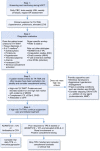Transplant-associated thrombotic microangiopathy: theoretical considerations and a practical approach to an unrefined diagnosis
- PMID: 33875812
- PMCID: PMC8338557
- DOI: 10.1038/s41409-021-01283-0
Transplant-associated thrombotic microangiopathy: theoretical considerations and a practical approach to an unrefined diagnosis
Abstract
Transplant-associated thrombotic microangiopathy (TA-TMA) is an increasingly recognized complication of hematopoietic stem cell transplant (HSCT) with high morbidity and mortality. The triad of endothelial cell activation, complement dysregulation, and microvascular hemolytic anemia has the potential to cause end organ dysfunction, multiple organ dysfunction syndrome and death, but clinical features mimic other disorders following HSCT, delaying diagnosis. Recent advances have implicated complement as a major contributor and the therapeutic potential of complement inhibition has been explored. Eculizumab has emerged as an effective therapy and narsoplimab (OMS721) has been granted priority review by the FDA. Large studies performed mostly in pediatric patients suggest that earlier recognition and treatment may lead to improved outcomes. Here we present a clinically focused summary of recently published literature and propose a diagnostic and treatment algorithm.
© 2021. The Author(s).
Conflict of interest statement
The author declares no competing interests.
Figures


References
-
- García-Martín P, Alarcón-Payer C, López-Fernández E, Moratalla L, Romero A, Sainz J, et al. Transplantation-associated thrombotic microangiopathy in patients treated with sirolimus and cyclosporine as salvage therapy for graft-versus-host disease. Ann Pharmacother. 2015;49:986–94. doi: 10.1177/1060028015593369. - DOI - PubMed
-
- Gavriilaki E, Sakellari I, Batsis I, Mallouri D, Bousiou Z, Vardi A, et al. Transplant-associated thrombotic microangiopathy: Incidence, prognostic factors, morbidity, and mortality in allogeneic hematopoietic cell transplantation. Clin Transplant. 2018;32:e13371. doi: 10.1111/ctr.13371. - DOI - PubMed
Publication types
MeSH terms
Substances
LinkOut - more resources
Full Text Sources
Other Literature Sources

